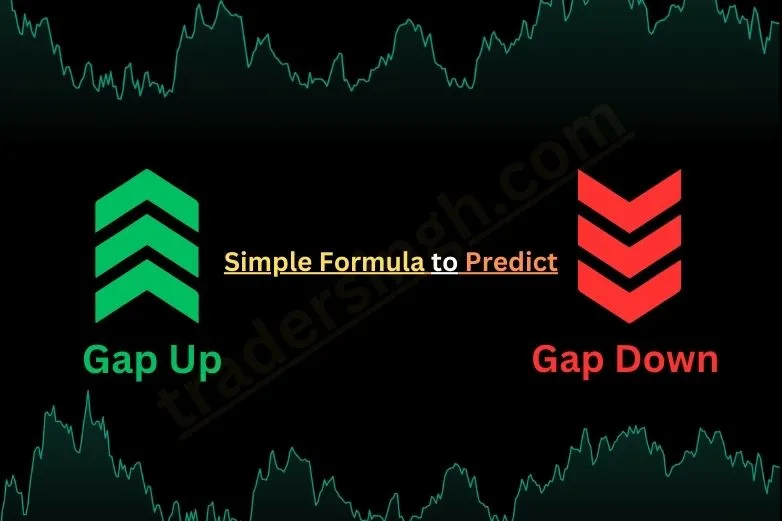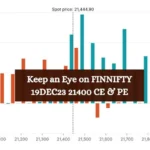For seasoned traders and investors, accurately predicting market trends can be the key to success. One way to anticipate how the Nifty and Bank Nifty will perform in the trading session is by examining the SGX Nifty, Singapore’s Nifty futures index.
By utilizing a simple formula and checking the Gift Nifty‘s price at 8:30 am, you can make an educated estimate of whether the market will open with a gap up or gap down.
In this article, we’ll walk you through the process step by step and provide examples for a better understanding.
Formula to Predict Gap Up and Gap Down in Nifty & Bank Nifty
To predict whether Nifty and Bank Nifty will gap up or gap down, follow this formula:
Percentage Change = [(SGX Nifty price at 8:30 am) – (SGX Nifty Previous day 3:30 pm price)] * 100 / SGX Nifty Previous day 3:30 pm price
Let’s illustrate this with examples.
Bullish Example:
Suppose the SGX Nifty is trading at 18,000 at 8:30 am, and the SGX Nifty’s previous day closing price was 17,500. Using the formula:
Percentage Change = [(18,000 – 17,500) * 100] / 17,500 = 2.86%
This means that Nifty is expected to open approximately 2.86% higher, indicating a bullish sentiment.
Bearish Example:
Conversely, if the SGX Nifty is trading at 18,000 at 8:30 am, and the previous day’s closing price was 18,500:

Percentage Change = [(18,000 – 18,500) * 100] / 18,500 = -2.71%
In this case, Nifty is expected to open approximately 2.71% lower, suggesting a bearish start to the trading session.
Global Sentiments and Dow Jones
Dow Jones, often referred to as the Dow, is one of the most closely monitored stock market indices globally. It comprises 30 large, publicly-traded US companies and is seen as an indicator of the overall health of the US stock market. The relationship between Dow Jones and Indian indices like Nifty and Bank Nifty is strong due to the interconnectedness of global financial markets.
- Dow Jones as a Leading Indicator: Dow Jones, being a leading indicator, can influence market sentiment in India. When Dow Jones futures close in the green, it indicates positive sentiment in the US markets. This positivity tends to spill over into other markets, including India, leading to a higher likelihood of a gap up opening in Nifty and Bank Nifty.
- Negative Sentiments in Dow Jones: Conversely, if Dow Jones experiences a negative trend, this can create uncertainty and risk aversion in the Indian market. This negative sentiment can lead to gap down openings in Nifty and Bank Nifty.
Favorable News in Indian and US Markets
Apart from Dow Jones, the occurrence of favorable news in the Indian or US markets can also impact the Nifty and Bank Nifty indices. This news can be related to economic data, corporate earnings, government policies, or international developments.
- Positive News: When there is good news in the Indian or US markets, such as robust economic growth, positive corporate results, or favorable government policies, it creates optimism among investors. This optimism often results in gap up openings in Nifty and Bank Nifty.
- Negative News: Conversely, unfavorable news, such as poor economic data, disappointing corporate earnings, or geopolitical tensions, can trigger risk aversion among investors, leading to gap down openings in these indices.
It’s important to exercise caution, especially at month ends when the SGX Nifty’s previous month contract expires. On such days, the formula may not work as expected. Ensure that you obtain the 3:30 pm price of the latest month’s contract for that particular day to make accurate predictions.
Additionally, note that the Nifty closing price and the Nifty 3:30 pm price are not always the same due to different calculation methods. However, this discrepancy is generally minimal and shouldn’t significantly impact your predictions.
Factors to Consider
- Previous Day’s Movement: Keep an eye on the previous day’s movements in the Nifty and Bank Nifty. These can often indicate the trend for the current day.
- SGX NIFTY’s Uptrend: If the SGX NIFTY futures are in an uptrend, the Bank Nifty is also likely to open with a gap up, but this isn’t a foolproof indicator.
- Legal Developments: Be mindful of any legal developments, as they can influence the performance of the Bank Nifty. For instance, Apex court hearings on moratorium and interest on interest can impact bank profits, and Supreme Court bans on declaring NPAs can affect loan recovery.
Conclusion
Predicting gap up and gap down openings in the Nifty and Bank Nifty can be a valuable skill for traders and investors. By following the simple formula and considering key factors, you can make more informed decisions in the ever-changing world of financial markets.
However, always exercise caution, especially during contract rollovers and be aware of external factors that might influence the market’s performance.




























